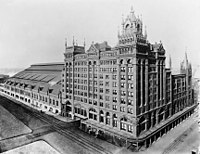The Philadelphia, Baltimore and Washington Railroad (PB&W) was a railroad that operated in Pennsylvania, Delaware, Maryland, and the District of Columbia in the 20th century, and was a key component of the Pennsylvania Railroad (PRR) system. Its 131-mile (211 km) main line ran between Philadelphia and Washington.[1]: 228 The PB&W main line is now part of the Northeast Corridor, owned by Amtrak.
 Map of the Philadelphia, Baltimore and Washington Railroad up to 1945 | |
 Broad Street Station, Philadelphia housed the headquarters offices of the PB&W until 1930. | |
| Overview | |
|---|---|
| Headquarters | Philadelphia (Broad Street Station) |
| Locale | Pennsylvania, Delaware, Maryland and Washington, D.C. |
| Dates of operation | 1902–1976 |
| Predecessor | Philadelphia, Wilmington and Baltimore Railroad Baltimore and Potomac Railroad Pittsburgh, Cincinnati, Chicago and St. Louis Railroad |
| Successor | Amtrak (passengers) Conrail system (freight) |
| Technical | |
| Track gauge | 4 ft 8+1⁄2 in (1,435 mm) standard gauge |
| Electrification | 12 kV 25 Hz |
| Length | 717 miles / 1,154 km (pre-PCC&StL merger) |
History
editThe railroad was formed in 1902 when the Pennsylvania Railroad merged two of its southern subsidiaries, the Philadelphia, Wilmington and Baltimore Railroad and the Baltimore and Potomac Railroad.[1]: 226
In 1907, the PB&W became a co-owner of the new Washington Terminal Company, which operated the new Washington Union Station, the marble structure dubbed the "Transportation Temple of America".[2]
In 1916, the PB&W operated 717 miles (1,154 km) of road, including 9 miles (14 km) of trackage rights.[1]: 226–227
Acquisitions
editThe PB&W acquired six railroad companies:
- 1906: South Chester Railroad
- 1913: Baltimore and Sparrow's Point Railroad, which provided freight service to Bethlehem Steel Corporation's Sparrows Point steel mill
- 1916: Philadelphia and Baltimore Central Railroad
- 1916: Columbia and Port Deposit Railway
- 1916: Elkton and Middletown Railroad
- 1956: Pittsburgh, Cincinnati, Chicago and St. Louis Railroad (Pan Handle Route)
Improvements
editIn 1928, the PRR began to electrify the main line between New York City and Washington, D.C., using catenary. Electrification of the PB&W portion was completed in 1935.[3] Amtrak still uses the 25 Hz traction power system.
Dissolution
editIn 1968, the Pennsylvania Railroad and its longtime rival New York Central Railroad merged to form the Penn Central Railroad. The PB&W remained a separate legal entity, although controlled and operated by the new company. The Penn Central declared bankruptcy in 1970 but continued to operate trains until 1976, when the company's railroad assets were sold under the Railroad Revitalization and Regulatory Reform Act. Under the new law, Congress authorized the sale of the PB&W right-of-way between Philadelphia and Washington, and related assets (such as the Washington Terminal Company), to Amtrak. Other PB&W assets, including almost all of the PCC&StL (Pan Handle), were sold to the new Consolidated Rail Corporation (Conrail).[4]: 122 [5]
In popular culture
edit- Flip Wilson's "Ugly Baby" (1965) routine is set on the Pennsylvania Railroad, outbound from Baltimore.[6][7]
See also
editReferences
edit- ^ a b c Poors Intermediate Manual of Railroads. New York: Poor's Manual Co. 1917.
- ^ Tindall, William (1914). Standard History of the City of Washington. Knoxville, TN: H.W. Crew. p. 418. Retrieved 2009-09-16.
washington terminal company.
- ^ "Electrification History to 1948". Pennsylvania Railroad Electrification. www.railsandtrails.com. Archived from the original on 2012-09-08. Retrieved 2010-05-24.
- ^ Schafer, Mike; Solomon, Brian (1997). Pennsylvania Railroad. Osceola, WI: MotorBooks International. ISBN 978-0-7603-0379-5. OCLC 36676055.
- ^ "Penn Central Railroad." Archived 2011-07-17 at the Wayback Machine Accessed 2010-05-23.
- ^ Wilson, Flip (1965). "Ugly Baby". Johnny Carson Show. Archived from the original on 2012-06-26.
- ^ Pompilio, Natalie. "Legends and Legacies: Flip Wilson". Legacy.com. Archived from the original on June 30, 2015. Retrieved June 27, 2015.
External links
edit- Philadelphia, Baltimore & Washington Railroad Company (1903). First Annual Report.
- Philadelphia, Baltimore & Washington Railroad Company (1904). Annual Report.